The need for ‘unified’ commerce and measurement standards dominated the conversation at this year’s event.
If you need some really tactical proof that shoppers need a “unified” commerce experience, here it is: 90% of the time that ShopRite customers scan QR codes to find the digital savings offers by the grocer, they’re inside a physical store.
There were many such examples of the need for an omnichannel approach to commerce marketing during this year’s Groceryshop — where the event’s content directors tried very hard to make “unified commerce” happen as the industry’s new rallying cry (if you’ll allow a Mean Girls paraphrase).
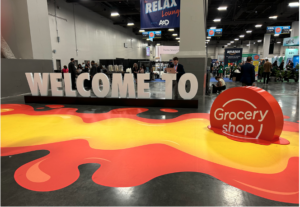
We at The Mars Agency thought the term “omnichannel” had long been replaced by “connected commerce,” which from our perspective requires both external alignment across all shopper touchpoints and internal alignment across all business functions. (The former can’t happen without the latter.)
But whatever you might want to call it, the need for connected commerce was the most common theme running throughout the three-day event, which this year featured 175 speakers, 4,000-odd attendees and an estimated 75,000 one-on-one meetings (as part of a new “MeetUp” program).
The second most common theme was the need to standardize retail media measurement, inspired in part by the IAB/MRC’s release of proposed measurement guidelines one week earlier, but more so by the fact that retail media continues to be the driving force across the entire commerce marketing landscape and is, therefore, under pretty intense scrutiny.
The following article takes a deeper look at those two themes, along with a few other key takeaways from the event.
The Shopper Journey Must Be Connected
Supermarket executives who took the stage all professed similar goals to create organizations that will make it “perfectly seamless” for shoppers to “bounce back and forth” across any of the sales and fulfillment channels that are available, in the words of Kroger CEO Rodney McMullen (below, left).
That requires building capabilities to deliver optimal shopping experiences “in whichever channel they want to shop in” rather than trying to guide them in any particular direction, said JJ Fleeman, CEO of Ahold Delhaize USA. “Job 1 is, ‘Don’t lose that customer,’” echoed McMullen.
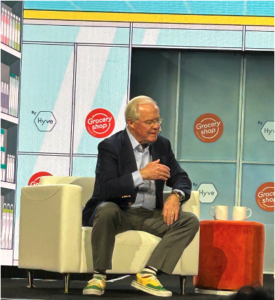
“It’s not about making [the journey] more digital unless the consumer wants to go there,” said Alanna McDonald, President of Mars Pet Nutrition North America, when asked about the company’s ecommerce strategy. (Insider Intelligence says that 39% of sales in the pet category take place online.) “It’s more about getting them the information they need to make the purchase where they want.”
Unified commerce “is really about loyalty and share of wallet,” said Steve Henig, Wakefern Food Corp.’s Chief Customer Officer (who provided the ShopRite QR code example). By excelling both in-store and online, “We get the big baskets and still get all the other trips.”
Seamless shopper journeys don’t happen without internal alignment, of course. Not too long ago, campaign planning at Treasury Wine Estates often included someone on the brand team asking, “Tammy, can you please fill in the ecommerce activation?” according to the person in question: VP-Retail Ecommerce Tammy Ackerman. Now, each component of the wine marketer’s 360-degree marketing plan is “developed, clarified, and connected to optimize execution and results” with “each tactic laddering back up to the objectives,” she said.
Organizations must take care to remain fluid and flexible when structuring for success, building to last rather than reacting to current, potentially short-term market conditions. “If we had done that during the pandemic, we’d have a lot to fix right now,” said Deepak Jose, Global Head of One Demand Data & Analytics Solutions at Mars Wrigley.
Everyone Wants Measurement Standards
Although the Groceryshop agenda didn’t devote any sessions to the topic, the need for of retail media standardization was a major talking point throughout the event. Speakers from both side of the negotiating table mention the issue — and more than a few as something that will ultimately happen.
That’s because the ability to measure commerce marketing in general and retail media in particular is still underdeveloped, which is hindering growth for both brands and retailers — and, in the latter case, impacting the retail media investments they’re gaining.
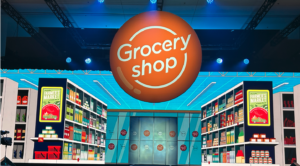
“You’ve got to get a consistent understanding [of performance]. It’s a real patchwork right now,” said Simon Miles, VP-Global OmniChannel Commercial Strategy at Coca-Cola. Conversations about which budget should fund retail media are “missing the point,” he said. “If [the media] performs, the money will flow.”
“I don’t care about getting reach,” said Imteaz Ahamed, Head of Performance Marketing for Nutrition at Reckitt, whose most pressing need is for clarity into “new to brand, incremental shoppers. But we’re not even getting proper PDP viewing data” at the moment.
There was pronounced consensus on the need for networks to measure incrementality “because that’s what will prove out. But it’s hard to perceive that happening without standardization,” said Miles. Gaining that understanding is “how I’ll be able to unlock spending,” added Jie Cheng, VP & Global Head of Digital Commerce at Mondelēz International.
One of PepsiCo’s key challenges is separating online and in-store data in order to accurately balance inventory, according to Meghan Archer, VP-Digital Commerce, Omni-Retail Transformation. Still, first-party data from retail media networks is filling a lot of knowledge gaps by helping the CPG identify shopper trends and potential pockets of growth.
While retailers need to provide the data, the onus on driving performance doesn’t rest solely in their court. “We have to put some more pressure on the brand side as well. Are we doing a good job on the fundamentals [of digital commerce] like PDPs?” asked Cheng. “You have to put your own house in order,” she said, noting that some CPGs “are not set up to make the most out of the media” because of internal silos.
The Retail Media Landscape Keeps Growing
While no one has conducted an official census yet (as far as we’ve heard), estimates at the show put the ranks of retail media networks as anywhere from 80 to 600.
And while there is definitely an understanding of the need to improve the shopper experience and give brand partners more effective avenues for engaging with shoppers, the business motivations behind these networks are also clear: With profitability under pressure, retail media is “a retailer’s greatest opportunity to build a high-margin revenue stream,” said Stewart Samuel, Director of Retail Futures at UK industry intelligence firm IGD.
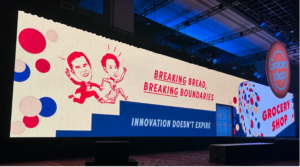
Secondary businesses like retail media delivered $1.2 billion in “alternative profit” to Kroger last year, which is helping the grocer invest in core low-margin initiatives like ecommerce and pricing, McMullen said. Fleeman similarly referred to the “inorganic” growth opportunities from digital media, where revenues are up 70% year over year.
“You have to be in this new [business to business] space. I don’t know how you’ll exist without it,” said Donna Tweeten, Co-President of Hy-Vee, who was on hand to officially launch the Des Moines, IA-based grocer’s RedMedia network.
Tweeten promised that RedMedia will be a “maverick” that will compete against national media, with its main point of differentiation being the “unique data touchpoints” provided by parent Hy-Vee’s diverse operating assets: along with 285 supermarkets in eight states, the list includes 190 c-stores, multiple restaurants, a bank, and an extensive healthcare business with national reach.
Year-old Dollar General Media Network’s unique selling proposition is access to rural Americans: 88% of the value chain’s 19,000-plus stores serve communities with populations below 20,000, noted Chad Fox, the retailer’s SVP & Chief Marketing Officer. [This audience] is “hard to reach and hard to measure.”
Such distinctive offerings will be important as the universe continues to expand because “there’s no way we’re buying across 600 platforms in any kind of sensible way,” said Miles. Even when standardized, business-driving measurement becomes available, there simply won’t be enough marketing dollars to go around.
“Not all RMNs are created equal,” noted Cheng. “The more mature ones that can deliver incremental sales are money well spent.”
Real collaboration will always be a determining factor on who earns the investments. PepsiCo is working to build collaborative partnerships that build retail media activity into the joint business planning process, Archer said. “This is a long-term relationship. We need to be able to help drive business goals.”
The Store Is (Finally?) Going Digital
Given the need for shoppers to have a connected journey — and for RMNs to deliver more unique ad inventory — the store might finally be getting the digital upgrade that’s long been heralded.
With all marketing eyes looking toward retail, it’s only logical for the place where 90% of grocery purchases are still taking place to become a focal point again. (Another stat: 70% of consumer say they’ll want to continue shopping in brick-and-mortar stores in the future, according to Barbara Connors, VP-Strategy & Acceleration at 84.51.

Groceryshop’s content team presented a laundry list of on-the-way tools: smart carts, fully loaded apps (scanning, wayfinding, aisle-based offers), digital displays, self-checkout screens and app-enabled sampling. In addition to bringing point-of purchase advertising to the retail media mix (helping to align brand and trade spending in the process), these opportunities will facilitate the personalization that shoppers are starting to expect.
Henig outlined the digital tools that Wakefern is using to improve the basics of shopping: purchase history access for list-making, order-ahead deli service, shopping lists sorted by store aisle, real-time out of stock updates. “For 50 years, people have been telling us, ‘We don’t want to wait on line,” said Henig, while explaining the benefits of scan & pay.
“It’s not possible to have a seamless journey” without digitizing the store, said Manish Sharma, VP & GM of Omni-commerce at The Kellogg Company. “We fully support that.” However, Sharma clarified the focus that must be taken when developing tools: “We don’t get behind shiny toys. We get behind consumers.”
Price Matters (for Some)
With inflation expected to continue through 2024, price will remain an issue for a substantial segment of consumers — but not for all. McMullen said Kroger is encountering two “buckets” of shoppers:
- Those legitimately under “economic stress” who’ve aggressively changed their behavior, buying more private label and smaller packages size, as well as eating at home more often.
- More upscale shoppers unaffected by the economic malaise who haven’t changed their habits and are still focused more on convenience than price.
For both groups, Kroger takes a “no compromise” approach, offering quality services (cut fruit, pre-sliced deli meat, ready-to-heat meals) and fresh food while “making sure all customers understand the value for their money,” McMullen said.
“It’s more about value and less about price. How risky is the purchase” for the consumer, said Anna Bell, SVP of Marketing for Central Garden & Pet.

Many consumers are looking for deals more frequently, which implies that they want to keep buying the same brands, according to Connors, but 50% are willing to switch if necessary in nearly all categories (except baby, pet, beauty and beverages), she said.
Retailers who court shoppers through product and price alone are putting themselves in jeopardy because “as soon your competitor has the better price, they are gone,” warned Mario Mijares, VP- Insights, Loyalty, Marketing & Monetization Platforms at 7-Eleven (at left).
It’s a Good Time for Private Label
One clear winner in the current economic climate has been own brands. “In the past 25 years, I have never seen private label exploding the way that it is right now — specifically at a retailer like Walmart,” said Karen Short, Managing Director at Credit Suisse.
When CPGs raise prices to something “more than economically viable … our brands gain scale,” said McMullen. (Smart Way, the umbrella brand for opening price points that Kroger launched last fall, is currently the fastest-growing private label, according to Numerator.)
Beyond own brands, Kroger is devoting shelf space to 30 additional locally sourced products in each store, helping drive growth for small, independent brands that “will probably sell out to a big CPG at some point,” McMullen suggested.
Generative AI Takes Root
The numbers of CPGs rolling out artificial intelligence tools to boost sales and marketing efficiency is increasing, while retailers are embracing the technology to enhance shopper engagement and experiences.
In addition to those two uses cases, the Groceryshop team added a third: improving creativity. “Internal applications are your proving ground,” recommended Director of Original Content Ben Miller.
More specifically, Tropicana Brands Group has implemented an in-house “TropGPT” to help with performance and data management, trend identification, content generation, and customer service, according to CEO Monica McGurk. Nestle (“NestGPT”) and Church & Dwight are conducting productivity exercises, summarizing articles and content, writing job descriptions, and running out-of-stock reports.
Direct to Consumer is a Great Start
Ultimately, any brand with ambitions to scale long-term needs to go “old school” at some point. Seven-year-old Curology grew to $200 million as a DTC, but “70% of skincare [volume] is still happening in the store,” said Heather Wallace, who was named CEO of the company last fall after serving as President of the Americas for Revlon. “We’ve got to build that connection in bricks and mortar.”
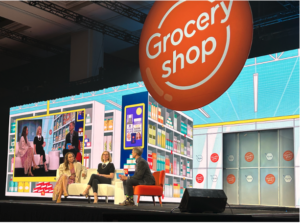
For Mars Petcare, the NomNomNow brand it purchased in 2022 is “more about the consumer insight that can be obtained” than the potential to extend DTC as a sales model across the company, said McDonald.
Similarly, Tropicana Brands has developed DTC capabilities “to speed up the learning process” and provide an avenue for personalized communication with consumers. But the CPG’s “bread and butter” remains omni-commerce, said McGurk.
Delivery Continues to Evolve
“There is a world of drones in your future. The novelty has worn off, and people are starting to use it in their daily lives,” promised Jennifer McKeehan, SVP of End to End Delivery for Walmart U.S. “Drones can deliver an order in less than 30 minutes. That’s faster than you can drive to a store in Chicago.”
